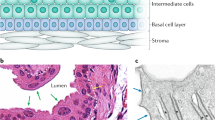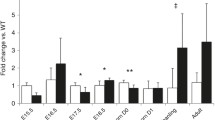Abstract
The clinical and financial impact of chronic kidney disease (CKD) is significant, while its progression and prognosis is variable and often poor. Studies using the megabladder (mgb −/−) model of CKD show that renal urothelium plays a key role in modulating early injury responses following the development of congenital obstruction. The aim of this review is to examine the role that urothelium has in normal urinary tract development and pathogenesis. We discuss normal morphology of renal urothelium and then examine the role that uroplakins (Upks) play in its development. Histologic, biochemical, and molecular characterization of Upk1b RFP/RFP mice indicated Upk1b expression is essential for normal urinary tract development, apical plaque/asymmetric membrane unit (AUM) formation, and differentiation and functional integrity of the renal urothelium. Our studies provide the first evidence that Upk1b is directly associated with the development of congenital anomalies of the urinary tract (CAKUT), spontaneous age-dependent hydronephrosis, and dysplastic urothelia. These observations demonstrate the importance of proper urothelial differentiation in normal development and pathogenesis of the urinary tract and provide a unique working model to test the hypothesis that the complex etiology associated with CKD is dependent upon predetermined genetic susceptibilities that establish pathogenic thresholds for disease initiation and progression.







Similar content being viewed by others
References
(2012) U.S. Renal data system, USRDS 2012 annual data report: atlas of chronic kidney disease and end-stage renal disease in the United States. National institutes of health, national institute of diabetes and digestive and kidney diseases, Bethesda, MD, 2012
(2007) U.S. Renal data system, USRDS 2007 annual data report: atlas of chronic kidney disease and end-stage renal disease in the United States. National institutes of health, national institute of diabetes and digestive and kidney diseases, Bethesda, MD
Wong CJ, Moxey-Mims M, Jerry-Fluker J, Warady BA, Furth SL (2012) CKiD (CKD in children) prospective cohort study: a review of current findings. Am J Kidney Dis 60:1002–1011
Roth KS, Carter WH Jr, Chan JC (2001) Obstructive nephropathy in children: long-term progression after relief of posterior urethral valve. Pediatrics 107:1004–1010
Ingraham SE, Saha M, Carpenter AR, Robinson M, Ismail I, Singh S, Hains D, Robinson ML, Hirselj DA, Koff SA, Bates CM, McHugh KM (2010) Pathogenesis of renal injury in the megabladder mouse: a genetic model of congenital obstructive nephropathy. Pediatr Res 68:500–507
Singh S, Robinson M, Nahi F, Coley B, Robinson ML, Bates CM, Kornacker K, McHugh KM (2007) Identification of a unique transgenic mouse line that develops megabladder, obstructive uropathy, and renal dysfunction. J Am Soc Nephrol 18:461–471
Aboushwareb T, Zhou G, Deng FM, Turner C, Andersson KE, Tar M, Zhao W, Melman A, D’Agostino R Jr, Sun TT, Christ GJ (2009) Alterations in bladder function associated with urothelial defects in uroplakin II and IIIa knockout mice. Neurourol Urodyn 28:1028–1033
Zhou G, Mo WJ, Sebbel P, Min G, Neubert TA, Glockshuber R, Wu XR, Sun TT, Kong XP (2001) Uroplakin Ia is the urothelial receptor for uropathogenic Escherichia coli: evidence from in vitro FimH binding. J Cell Sci 114:4095–4103
Hu P, Deng FM, Liang FX, Hu CM, Auerbach AB, Shapiro E, Wu XR, Kachar B, Sun TT (2000) Ablation of uroplakin III gene results in small urothelial plaques, urothelial leakage, and vesicoureteral reflux. J Cell Biol 151:961–972
Kong XT, Deng FM, Hu P, Liang FX, Zhou G, Auerbach AB, Genieser N, Nelson PK, Robbins ES, Shapiro E, Kachar B, Sun TT (2004) Roles of uroplakins in plaque formation, umbrella cell enlargement, and urinary tract diseases. J Cell Biol 167:1195–1204
Romih R, Korosec P, De Mello W Jr, Jezernik K (2005) Differentiation of epithelial cells in the urinary tract. Cell Tissue Res 320:259–268
Carpenter AR, Becknell B, Ching CB, Cuaresma EJ, Chen X, Hains DS, McHugh KM (2016) Uroplakin 1b is critical in urinary tract development and urothelial differentiation and homeostasis. Kidney Int 89:612–624
Wu XR, Lin JH, Walz T, Haner M, Yu J, Aebi U, Sun TT (1994) Mammalian uroplakins. A group of highly conserved urothelial differentiation-related membrane proteins. J Biol Chem 269:13716–13724
Garcia-Espana A, Chung PJ, Zhao X, Lee A, Pellicer A, Yu J, Sun TT, Desalle R (2006) Origin of the tetraspanin uroplakins and their co- evolution with associated proteins: implications for uroplakin structure and function. Mol Phylogenet Evol 41:355–367
Deng FM, Liang FX, Tu L, Resing KA, Hu P, Supino M, Hu CC, Zhou G, Ding M, Kreibich G, Sun TT (2002) Uroplakin IIIb, a urothelial differentiation marker, dimerizes with uroplakin Ib as an early step of urothelial plaque assembly. J Cell Biol 159:685–694
Yu J, Lin JH, Wu XR, Sun TT (1994) Uroplakins Ia and Ib, two major differentiation products of bladder epithelium, belong to a family of four transmembrane domain (4TM) proteins. J Cell Biol 125:171–182
Wu XR, Medina JJ, Sun TT (1995) Selective interactions of UPIa and UPIb, two members of the transmembrane 4 superfamily, with distinct single transmembrane-domained proteins in differentiated urothelial cells. J Biol Chem 270:29752–29759
Liang FX, Riedel I, Deng FM, Zhou G, Xu C, Wu XR, Kong XP, Moll R, Sun TT (2001) Organization of uroplakin subunits: transmembrane topology, pair formation and plaque composition. Biochem J 355:13–18
Hu CC, Liang FX, Zhou G, Tu L, Tang CH, Zhou J, Kreibich G, Sun TT (2005) Assembly of urothelial plaques: tetraspanin function in membrane protein trafficking. Mol Biol Cell 16:3937–3950
Min G, Stolz M, Zhou G, Liang F, Sebbel P, Stoffler D, Glockshuber R, Sun TT, Aebi U, Kong XP (2002) Localization of uroplakin Ia, the urothelial receptor for bacterial adhesin FimH, on the six inner domains of the 16 nm urothelial plaque particle. J Mol Biol 317:697–706
Sakakibara K, Sato K, Yoshino K, Oshiro N, Hirahara S, Mahbub Hasan AK, Iwasaki T, Ueda Y, Iwao Y, Yonezawa K, Fukami Y (2005) Molecular identification and characterization of Xenopus egg uroplakin III, an egg raft-associated transmembrane protein that is tyrosine-phosphorylated upon fertilization. J Biol Chem 280:15029–15037
Jenkins D, Bitner-Glindzicz M, Malcolm S, Hu CC, Allison J, Winyard PJ, Gullett AM, Thomas DF, Belk RA, Feather SA, Sun TT, Woolf AS (2005) De novo Uroplakin IIIa heterozygous mutations cause human renal adysplasia leading to severe kidney failure. J Am Soc Nephrol 16:2141–2149
Wang H, Min G, Glockshuber R, Sun TT, Kong XP (2009) Uropathogenic E. coli adhesin-induced host cell receptor conformational changes: implications in transmembrane signaling transduction. J Mol Biol 392:352–361
Thumbikat P, Berry RE, Zhou G, Billips BK, Yaggie RE, Zaichuk T, Sun TT, Schaeffer AJ, Klumpp DJ (2009) Bacteria-induced uroplakin signaling mediates bladder response to infection. PLoS Pathog 5:e1000415
Tu L, Kong XP, Sun TT, Kreibich G (2006) Integrity of all four transmembrane domains of the tetraspanin uroplakin Ib is required for its exit from the ER. J Cell Sci 119:5077–5086
Becknell B, Carpenter AR, Allen JL, Wilhide ME, Ingraham SE, Hains DS, McHugh KM (2013) Molecular basis of renal adaptation in a murine model of congenital obstructive nephropathy. PLoS One 8:e72762
Vinsonneau C, Girshovich A, M’Rad MB, Perez J, Mesnard L, Vandermersch S, Placier S, Letavernier E, Baud L, Haymann JP (2010) Intrarenal urothelium proliferation: an unexpected early event following ischemic injury. Am J Physiol Renal Pysiol 299:F479–F486
Girshovich A, Vinsonneau C, Perez J, Vandermeersch S, Verpont MC, Placier S, Jouanneau C, Letavernier E, Baud L, Haymann JP (2012) Ureteral obstruction promotes proliferation and differentiation of the renal urothelium into a bladder-like phenotype. Kidney Int 82:428–435
Wood MW, Breitschwerdt EB, Nordone SK, Linder KE, Gookin JL (2012) Uropathogenic E. coli promote a paracellular urothelial barrier defect characterized by altered tight junction integrity, epithelial cell sloughing and cytokine release. J Comp Pathol 147:11–19
Shin K, Lee J, Guo N, Kim J, Lim A, Qu L, Mysorekar IU, Beachy PA (2011) Hedgehog/Wnt feedback supports regenerative proliferation of epithelial stem cells in bladder. Nature 472:110–114
McHugh KM (2014) Megabladder mouse model of congenital obstructive nephropathy: genetic etiology and renal adaptation. Pediatr Nephrol 29:645–650
Becknell B, Mohamed AZ, Li B, Wilhide ME, Ingraham SE (2015) Urine stasis predisposes to urinary tract infection by an opportunistic uropathogen in the megabladder (Mgb) mouse. PLoS One 10:e0139077
McMahon AP, Aronow BJ, Davidson DR, Davies JA, Gaido KW, Grimmond S, Lessard JL, Little MH, Potter SS, Wilder EL, Zhang P, project G (2008) GUDMAP: the genitourinary developmental molecular anatomy project. J Am Soc Nephrol 19:667–671
Mauney JR, Ramachandran A, Yu RN, Daley GQ, Adam RM, Estrada CR (2010) All-trans retinoic acid directs urothelial specification of murine embryonic stem cells via GATA4/6 signaling mechanisms. PLoS One 5:e11513
Adachi W, Okubo K, Kinoshita S (2000) Human uroplakin Ib in ocular surface epithelium. Invest Ophthalmol Vis Sci 41:2900–2905
Harding SD, Armit C, Armstrong J, Brennan J, Cheng Y, Haggarty B, Houghton D, Lloyd-MacGilp S, Pi X, Roochun Y, Sharghi M, Tindal C, McMahon AP, Gottesman B, Little MH, Georgas K, Aronow BJ, Potter SS, Brunskill EW, Southard-Smith EM, Mendelsohn C, Baldock RA, Davies JA, Davidson D (2011) The GUDMAP database--an online resource for genitourinary research. Development 138:2845–2853
Smith CM, Finger JH, Hayamizu TF, McCright IJ, Xu J, Berghout J, Campbell J, Corbani LE, Forthofer KL, Frost PJ, Miers D, Shaw DR, Stone KR, Eppig JT, Kadin JA, Richardson JE, Ringwald M (2014) The mouse gene expression database (GXD): 2014 update. Nucleic Acids Res 42:D818–D824
Thumbikat P, Berry RE, Schaeffer AJ, Klumpp DJ (2009) Differentiation- induced uroplakin III expression promotes urothelial cell death in response to uropathogenic E. coli. Microbes Infect 11:57–65
Ogawa K, Johansson SL, Cohen SM (1999) Immunohistochemical analysis of uroplakins, urothelial specific proteins, in ovarian Brenner tumors, normal tissues, and benign and neoplastic lesions of the female genital tract. Am J Pathol 155:1047–1050
Cheng L, Cheville JC, Neumann RM, Bostwick DG (1999) Natural history of urothelial dysplasia of the bladder. Am J Surg Pathol 23:443–447
Siegel R, Naishadham D, Jemal A (2013) Cancer statistics, 2013. CA Cancer J Clin 63:11–30
Raman JD, Ng CK, Boorjian SA, Vaughan ED Jr, Sosa RE, Scherr DS (2005) Bladder cancer after managing upper urinary tract transitional cell carcinoma: predictive factors and pathology. BJU Int 96:1031–1035
Chow WH, Lindblad P, Gridley G, Nyren O, McLaughlin JK, Linet MS, Pennello GA, Adami HO, Fraumeni JF Jr (1997) Risk of urinary tract cancers following kidney or ureter stones. J Natl Cancer Inst 89:1453–1457
Saran R, Li Y, Robinson B, Ayanian J, Balkrishnan R, Bragg-Gresham J, Chen JT, Cope E, Gipson D, He K, Herman W, Heung M, Hirth RA, Jacobsen SS, Kalantar-Zadeh K, Kovesdy CP, Leichtman AB, Lu Y, Molnar MZ, Morgenstern H, Nallamothu B, O’Hare AM, Pisoni R, Plattner B, Port FK, Rao P, Rhee CM, Schaubel DE, Selewski DT, Shahinian V, Sim JJ, Song P, Streja E, Kurella Tamura M, Tentori F, Eggers PW, Agodoa LY, Abbott KC (2015) US renal data system 2014 annual data report: epidemiology of kidney disease in the United States. Am J Kidney Dis 65:A7
Acknowledgments
This article used data from the GenitoUrinary Development Molecular Anatomy Project (GUDMAP) database http://www.gudmap.org [12/2015], including microarray (Capel, Gaido, Lessard, Potter & Southard-Smith Laboratories) data.
Author information
Authors and Affiliations
Corresponding author
Ethics declarations
Conflict of interest
The authors declare no conflict of interest.
Rights and permissions
About this article
Cite this article
Carpenter, A.R., McHugh, K.M. Role of renal urothelium in the development and progression of kidney disease. Pediatr Nephrol 32, 557–564 (2017). https://doi.org/10.1007/s00467-016-3385-6
Received:
Revised:
Accepted:
Published:
Issue Date:
DOI: https://doi.org/10.1007/s00467-016-3385-6




